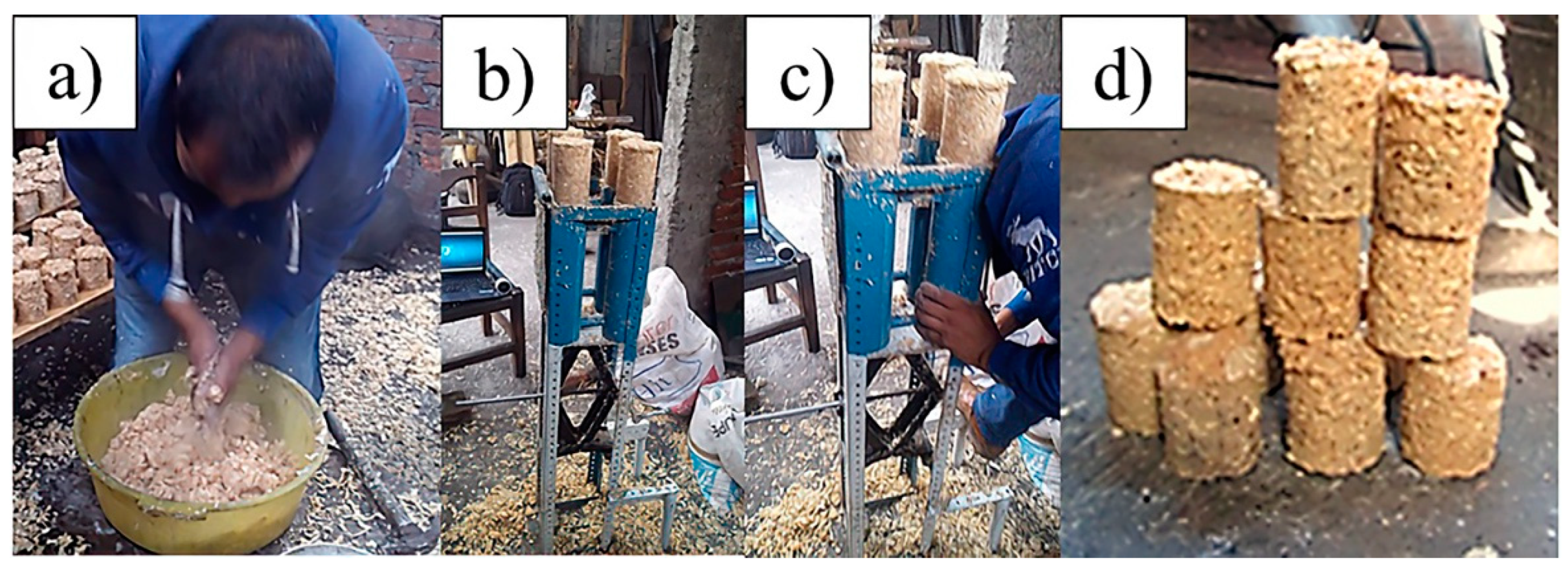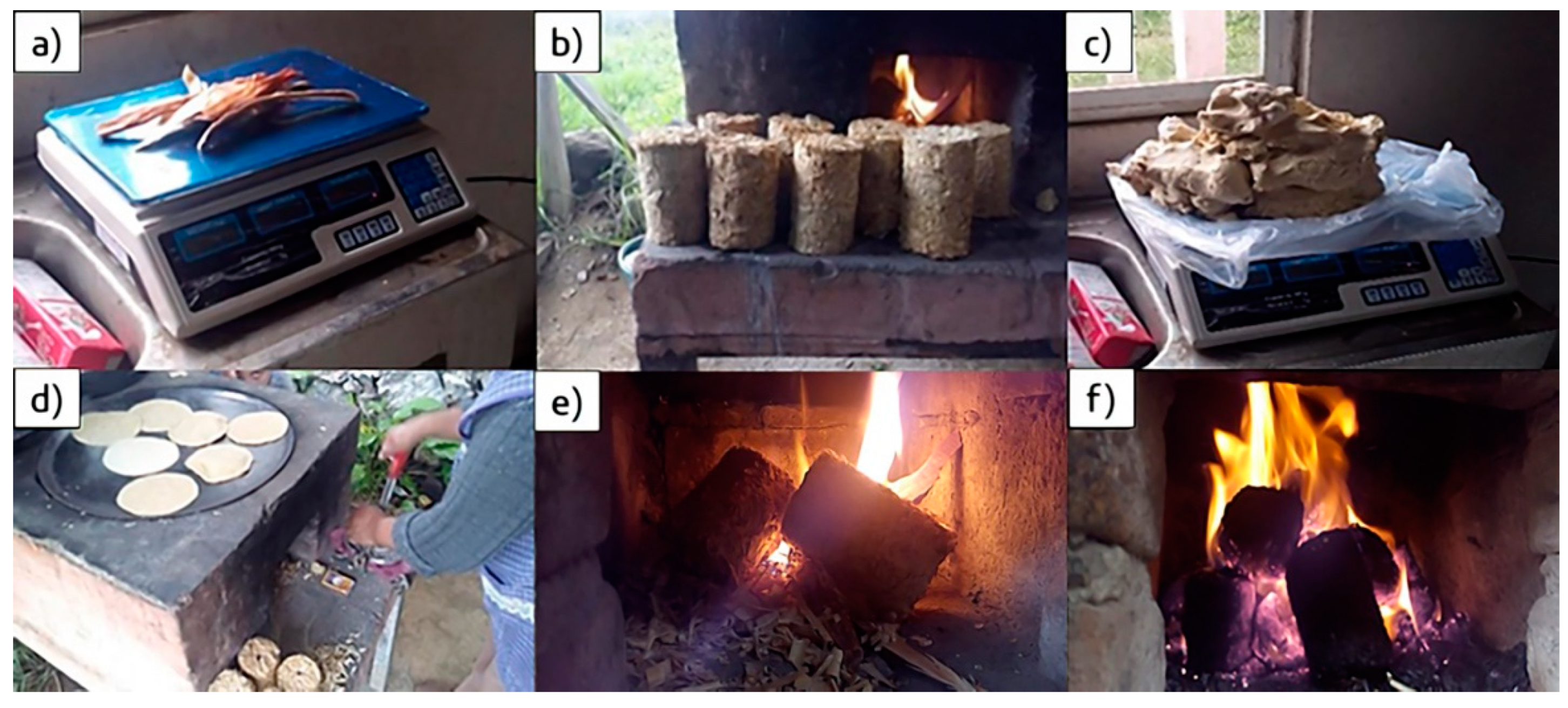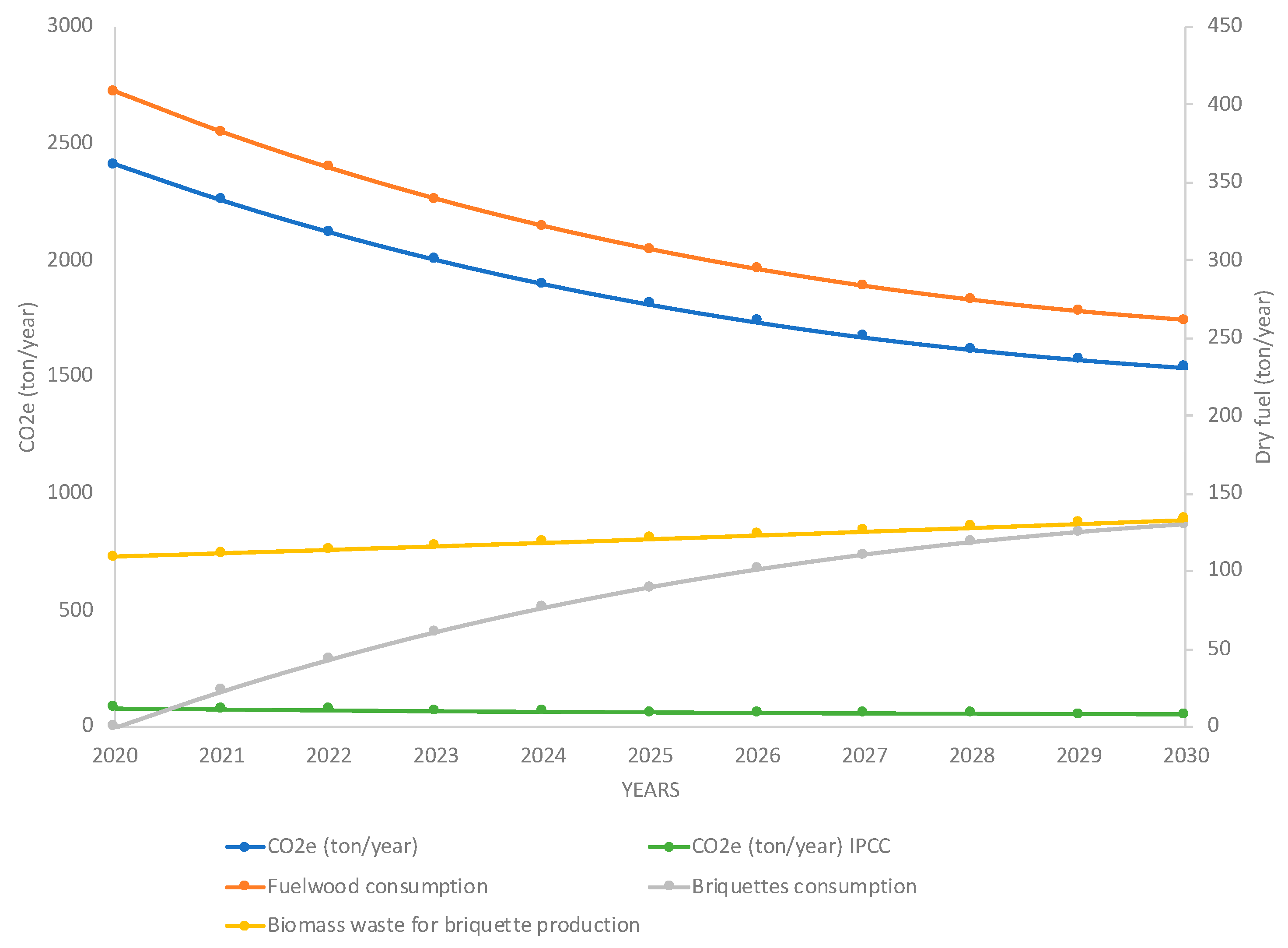Briquettes from Pinus spp. Residues: Energy Savings and Emissions Mitigation in the Rural Sector
Abstract
1. Introduction
2. Materials and Methods
2.1. Survey Campaign and Diagnosis of Needs
2.2. Biomass Potential Assessment
2.3. Measurements
2.3.1. Laboratory
2.3.2. Field
2.4. Scenarios
2.4.1. Greenhouse Gas Mitigation
2.4.2. Energy Savings
3. Results
3.1. Diagnosis of the Generation of Timber Residue
3.2. Economic Evaluation of the Production and Use of Briquettes
3.3. Lab and Field Performance
3.3.1. Laboratory
3.3.2. Field
3.4. Scenarios
3.4.1. CO2e
3.4.2. Energy Savings
4. Discussion
4.1. Energy Needs and Energy Transition
4.2. Greenhouse Gas Mitigation and Energy Savings
5. Conclusions
- It is necessary to learn about the energy needs of the community to propose a partial solution. A full replacement of fuelwood could lead to misplaced expectations. Note that 45% of users cook with fuelwood exclusively, while 55% cook with fuelwood and LPG.
- With the use of biomass residues, it is possible to produce briquettes at a similar cost to or cheaper than fuelwood. This might generate a local market with local benefits.
- Briquettes examined in this study could be the most effective stacking option in terms of fuelwood savings and GHG mitigation. The use of briquettes on the Patsari stove showed energy savings of 12% compared to the “U” type open fire. Laboratory tests showed that briquettes gasification to heat water reduces 74% of GHG emissions.
Author Contributions
Funding
Institutional Review Board Statement
Informed Consent Statement
Data Availability Statement
Acknowledgments
Conflicts of Interest
References
- Bajwa, D.S.; Peterson, T.; Sharma, N.; Shojaeiarani, J.; Bajwa, S.G. A Review of Densified Solid Biomass for Energy Production. Renew. Sustain. Energy Rev. 2018, 96, 296–305. [Google Scholar] [CrossRef]
- Schilmann, A.; Ruiz-García, V.; Serrano-Medrano, M.; De La Sierra De La Vega, L.A.; Olaya-García, B.; Estevez-García, J.A.; Berrueta, V.; Riojas-Rodríguez, H.; Masera, O. Just and Fair Household Energy Transition in Rural Latin American Households: Are We Moving Forward? Environ. Res. Lett. 2021, 16, 105012. [Google Scholar] [CrossRef]
- García-Frapolli, E.; Schilmann, A.; Berrueta, V.M.; Riojas-Rodríguez, H.; Edwards, R.D.; Johnson, M.; Guevara-Sanginés, A.; Armendariz, C.; Masera, O. Beyond Fuelwood Savings: Valuing the Economic Benefits of Introducing Improved Biomass Cookstoves in the Purépecha Region of Mexico. Ecol. Econ. 2010, 69, 2598–2605. [Google Scholar] [CrossRef]
- Welfle, A.; Chingaira, S.; Kassenov, A. Biomass and Bioenergy Decarbonising Kenya’s Domestic & Industry Sectors through Bioenergy: An Assessment of Biomass Resource Potential & GHG Performances. Biomass Bioenergy 2020, 142, 105757. [Google Scholar] [CrossRef]
- Ramíres-Ramírez, M.A.; Carrillo-Parra, A.; Ruíz-Aquino, F.; Hernández-Solís, J.J.; Pintor-Ibarra, L.F.; González-Ortega, N.; Orihuela-Equihua, R.; Carrillo-Ávila, N.; Rutiaga-Quiñones, J.G. Evaluation of Selected Physical and Thermal Properties of Briquette Hardwood Biomass Biofuel. BioEnergy Res. 2022. [Google Scholar] [CrossRef]
- Tauro, R.; García, C.A.; Skutsch, M.; Masera, O. The Potential for Sustainable Biomass Pellets in Mexico: An Analysis of Energy Potential, Logistic Costs and Market Demand. Renew. Sustain. Energy Rev. 2018, 82, 380–389. [Google Scholar] [CrossRef]
- Rios, M.; Kaltschmitt, M. Bioenergy Potential in Mexico-Status and Perspectives on a High Spatial Distribution. Biomass Convers. Biorefinery 2013, 3, 239–254. [Google Scholar] [CrossRef]
- Morales-Máximo, M.; Ruíz-García, V.M.; López-Sosa, L.B.; Rutiaga-Quiñones, J.G. Exploitation of Wood Waste of Pinus Spp for Briquette Production: A Case Study in the Community of San Francisco Pichátaro, Michoacán, Mexico. Appl. Sci. 2020, 10, 2933. [Google Scholar] [CrossRef]
- Muller, A. Sustainable Farming of Bioenergy Crops; Elsevier: Zurich, Switzerland, 2014; ISBN 9780444595614. [Google Scholar]
- Fekadu, M.; Bekele, T.; Feleke, S. Problems of Mirt, and Potentials of Improved Gonzie and Traditional Open Cook Stoves in Biomass Consumption and End Use Emission in Rural Wooden Houses of Southern Ethiopia. Sci. Afr. 2019, 3, e00064. [Google Scholar] [CrossRef]
- Medina, P.; Berrueta, V.; Martínez, M.; Ruiz, V.; Edwards, R.D.; Masera, O. Comparative Performance of Five Mexican Plancha-Type Cookstoves Using Water Boiling Tests. Dev. Eng. 2015, 2, 20–28. [Google Scholar] [CrossRef]
- Ruiz-García, V.M.; Edwards, R.D.; Ghasemian, M.; Berrueta, V.M.; Princevac, M.; Vázquez, J.C.; Johnson, M.; Masera, O.R. Fugitive Emissions and Health Implications of Plancha-Type Stoves. Environ. Sci. Technol. 2018, 52, 10848–10855. [Google Scholar] [CrossRef] [PubMed]
- Medina, P.; Berrueta, V.; Martínez, M.; Ruiz, V.; Ruiz-Mercado, I.; Masera, O.R. Closing the Gap between Lab and Field Cookstove Tests: Benefits of Multi-Pot and Sequencing Cooking Tasks through Controlled Burning Cycles. Energy Sustain. Dev. 2017, 41, 106–111. [Google Scholar] [CrossRef]
- Berrueta, V.M.; Edwards, R.D.; Masera, O.R. Energy Performance of Wood-Burning Cookstoves in Michoacan, Mexico. Renew. Energy 2008, 33, 859–870. [Google Scholar] [CrossRef]
- Ruiz-García, V.; Medina, P.; Vázquez, J.; Villanueva, D.; Ramos, S.; Masera, O. Bioenergy Devices: Energy and Emissions Performance for the Residential and Industrial Sectors in Mexico. Bioenergy Res. 2021. [Google Scholar] [CrossRef]
- Kothari, R.; Vashishtha, A.; Mohan, H. Assessment of Indian Bioenergy Policy for Sustainable Environment and Its Impact for Rural India: Strategic Implementation and Challenges. Environ. Technol. Innov. 2020, 20, 101078. [Google Scholar] [CrossRef]
- El Mekaoui, A.; Tariq, R.; Méndez-Monroy, P.E. Sustainability, Sociocultural Challenges, and New Power of Capitalism for Renewable Energy Megaprojects in an Indigenous Mayan Community of Mexico. Sustainability 2020, 12, 7432. [Google Scholar] [CrossRef]
- Serrano-Medrano, M.; García-Bustamante, C.; Berrueta, V.M.; Martínez-Bravo, R.; Ruiz-García, V.M.; Ghilardi, A.; Masera, O. Promoting LPG, Clean Woodburning Cookstoves or Both? Climate Change Mitigation Implications of Integrated Household Energy Transition Scenarios in Rural Mexico. Environ. Res. Lett. 2018, 13, 11. [Google Scholar] [CrossRef]
- Morales-Máximo, M.; Castro Sánchez, F.J.; Rutiaga-Quiñones, J.G. Estudio Socioeconómico Para La Evaluación de Biocombustibles Sólidos: Eficiencia Energética y Alterna En La Comunidad de San Francisco Pichátaro, Michoacán, México. Int. Energy Conf. 2019, 2, 577–582. [Google Scholar]
- López-Sosa, L.B.; Núñez-González, J.; Beltrán, A.; Morales-Máximo, M.; Morales-Sánchez, M.; Serrano-Medrano, M.; García, C.A. A New Methodology for the Development of Appropriate Technology: A Case Study for the Development of a Wood Solar Dryer. Sustainability 2019, 11, 5620. [Google Scholar] [CrossRef]
- Leal Filho, W.; Noyola-Cherpitel, R.; Medellín-Milán, P.; Vargas, V.R. (Eds.) Sustainable and Selected Latin and Practice in Mexico Development Research American Countries; Springer: Cham, Switzerland, 2018; ISBN 9783319705590. [Google Scholar]
- Riegelhaupt, E.; Gutierrez, J.P.; Catana, A. Quemadores de Biocombustibles Sólidos: Una Prueba de Concepto; 2015; pp. 1–21. Available online: https://docs.google.com/presentation/d/0B45ZBweQXdZ8ck91cm44UDk3MkU/edit?resourcekey=0-1OHWzQwBz98Dq5JZrXG7XA#slide=id.p1 (accessed on 1 March 2022).
- Jetter, J.; Zhao, Y.; Smith, K.R.; Khan, B.; Yelverton, T.; Decarlo, P.; Hays, M.D. Pollutant Emissions and Energy Efficiency under Controlled Conditions for Household Biomass Cookstoves and Implications for Metrics Useful in Setting International Test Standards. Environ. Sci. Technol. 2012, 46, 10827–10834. [Google Scholar] [CrossRef]
- MacCarty, N.; Still, D.; Ogle, D. Fuel Use and Emissions Performance of Fifty Cooking Stoves in the Laboratory and Related Benchmarks of Performance. Energy Sustain. Dev. 2010, 14, 161–171. [Google Scholar] [CrossRef]
- Ortínez-Alvarez, A.; Peralta, O.; Alvarez-Ospina, H.; Martínez-Arroyo, A.; Castro, T.; Páramo, V.H.; Ruiz-Suárez, L.G.; Garza, J.; Saavedra, I.; de la Luz Espinosa, M.; et al. Concentration Profile of Elemental and Organic Carbon and Personal Exposure to Other Pollutants from Brick Kilns in Durango, Mexico. Air Qual. Atmos. Health 2017, 11, 285–300. [Google Scholar] [CrossRef]
- Vicente, E.D.; Duarte, M.A.; Tarelho, L.A.C.; Nunes, T.F.; Amato, F.; Querol, X.; Colombi, C.; Gianelle, V.; Alves, C.A. Particulate and Gaseous Emissions from the Combustion of Different Biofuels in a Pellet Stove. Atmos. Environ. 2015, 120, 15–27. [Google Scholar] [CrossRef]
- IPCC. Climate Change 2014 Impacts, Adaptation, and Vulnerability; Press, C.U., Ed.; Cambridge University Press: Cambridge, UK, 2014. [Google Scholar]
- IPCC. Cambio Climático 2007: Informe de Síntesis de Expertos Sobre El Cambio Climático; Ginebra: Ginebra, Suiza, 2007. [Google Scholar]
- Edwards, R.D.; Smith, K.R. Carbon Balances, Global Warming Commitments, and Health Implications of Avoidable Emissions from Residential Energy Use in China: Evidence from an Emissions Database. Available online: http://www.giss.nasa.gov/meetings/pollution2002/d3_edwards.html (accessed on 2 May 2020).
- MacCarty, N.; Ogle, D.; Still, D.; Bond, T.; Roden, C. A Laboratory Comparison of the Global Warming Impact of Five Major Types of Biomass Cooking Stoves. Energy Sustain. Dev. 2008, 12, 56–65. [Google Scholar] [CrossRef]
- Bailis, R.; Drigo, R.; Ghilardi, A.; Masera, O. The Carbon Footprint of Traditional Woodfuels. Nat. Clim. Chang. 2015, 5, 266–272. [Google Scholar] [CrossRef]
- Obi, O.F.; Ezema, J.C.; Okonkwo, W.I. Energy Performance of Biomass Cookstoves Using Fuel Briquettes. Biofuels 2020, 11, 467–478. [Google Scholar] [CrossRef]
- Johnson, M.; Edwards, R.; Alatorre Frenk, C.; Masera, O. In-Field Greenhouse Gas Emissions from Cookstoves in Rural Mexican Households. Atmos. Environ. 2008, 42, 1206–1222. [Google Scholar] [CrossRef]
- Kraszkiewicz, A.; Niedziółka, I.; Parafiniuk, S.; Sprawka, M.; Dula, M. Assessment of Selected Physical Characteristics of the English Ryegrass (Lolium perenne L.) Waste Biomass Briquettes. Agric. Eng. 2020, 23, 21–30. [Google Scholar] [CrossRef]
- Qi, J.; Li, Q.; Wu, J.; Jiang, J.; Miao, Z.; Li, D. Biocoal Briquettes Combusted in a Household Cooking Stove: Improved Thermal Efficiencies and Reduced Pollutant Emissions. Environ. Sci. Technol. 2017, 51, 1886–1892. [Google Scholar] [CrossRef]
- Chungcharoen, T.; Srisang, N. Preparation and Characterization of Fuel Briquettes Made from Dual Agricultural Waste: Cashew Nut Shells and Areca Nuts. J. Clean. Prod. 2020, 256, 120434. [Google Scholar] [CrossRef]
- INEGI. Catálogo de Claves de Entidades Federativas, Municipios y Localidades; INEGI: Michoacán, México, 2015; Available online: http://www.cuentame.inegi.org.mx/monografias/informacion/mich/poblacion/dinamica.aspx?tema=me&e=16 (accessed on 1 January 2021).
- SEDESOL. Programa Para El Desarrollo de Zonas Prioritarias (PDZP); SEDESOL: Michoacán, México, 2010; Available online: http://www.microrregiones.gob.mx/catloc/contenido.aspx?refnac=160900007 (accessed on 1 October 2021).
- Smith, K.R.; Uma, R.; Kishore, V.V.N.; Zhang, J.; Joshi, V.; Khalil, M.A.K. Greenhouse Implications of Household Stoves: An Analysis for India. Annu. Rev. Energy Environ. 2000, 25, 741–763. [Google Scholar] [CrossRef]
- Carrilo-Parra, A.; Contreras Ortiz, E.; Garza-Ocañas, F.; Ngangyo Heya, M.; Rutiaga-Quiñones, J.G. Efecto de La Intemperización y Proceso En Las Características Físicas, Mecánicas y Energéticas de Briquetas Weathering and Process Effects on Physical, Mechanical and Energy Characteristics of Briquettes. Rev. Mex. Cienc. For. 2018, 9, 50. [Google Scholar] [CrossRef][Green Version]
- Pérez-Pérez, J.E.; Carrillo-Parra, A.; Rutiaga-Quiñones, J.G.; Bustamante-García, V.; Garza-Ocañas, F. Efecto Del Tipo de Material, Presión y Temperatura En La Densidad de Briquetas de Residuos Industriales de Tres Especies Del Género Pinus. Cienc. Nicolaita 2016, 68, 80–89. [Google Scholar]
- Cooke, P. Transversality and Transition: Green Innovation and New Regional Path Creation. Eur. Plan. Stud. 2012, 20, 817–834. [Google Scholar] [CrossRef]
- Rahaman, S.A.; Salam, P.A. Characterization of Cold Densified Rice Straw Briquettes and the Potential Use of Sawdust as Binder. Fuel Processing Technol. 2017, 158, 9–19. [Google Scholar] [CrossRef]





| Biomass Residue Uses | |||||||||
| Use type | Cooking | Heating water | Drying wood | Cleaning | Uncontrolled burning | Landfill | Fertilizer | Sale | Outdoor storage |
| (%) | 5.6 | 14.8 | 9.3 | 5.6 | 33.0 | 3.8 | 3.8 | 18.5 | 5.6 |
| Biomass residue generation | |||||||||
| Residue type | Wood shavings | Sawdust | |||||||
| Generation (t/year) | 9.1 ± 0.6 | 6.6 ± 0.2 | |||||||
| Energy consumption patterns in the residential sector | |||||||||
| Fuel type | LPG | Woodfuel | Both | ||||||
| (%) | 4.6 | 45.2 | 50.2 | ||||||
| Fuelwood use frequency in the residential sector | |||||||||
| Frequency | Daily | 2 to 3 time weekly | 2 to 3 time monthly | ||||||
| (%) | 65.3 | 25.1 | 9.6 | ||||||
| Woodfuel consumption | |||||||||
| Homes (%) | 15 | 25 | 20 | 40 | |||||
| Range (kg/week) | 15–19 | 20–23 | 24–27 | >39 | |||||
| Supplying fuelwood | |||||||||
| Activity type | Buy | Gift | Forest extraction | ||||||
| (%) | 50 ± 3 | 29 ± 2 % | 20 ± 2 % | ||||||
| Fuel Type | Briquette without Binder | Briquette with Binder | Pinus spp. Fuelwood | Quercus spp. Fuelwood |
|---|---|---|---|---|
| USD/t dry mass | 31 | 282 | 182 | 224 |
| Energy Performance | ||
| Parameters | Gasifier | Three-stone fire |
| Cooking time (min) | 21 ± 6 | 24 ± 5 |
| Burning rate (g/min) | 20 ± 4 | 27 ± 7 |
| Fuel consumption (g) | 413 ± 16 | 629 ± 46 |
| Power (kW) | 6 ± 1 | 8 ± 2 |
| Thermal Efficiency (%) | 24 ± 2 | 17 ± 1 |
| Emission Factor per Dry Fuel Consumption | ||
| Parameter | Gasifier | Three-stone fire |
| gCO2/kg | 310 ± 75 | 1140 ± 123 |
| gCO/kg | 12 ± 5 | 32 ± 9 |
| mg CH4/kg | 233 ± 124 | 716 ± 272 |
| mg NMHC/kg | 555 ± 285 | 1350 ± 680 |
| mg PM2.5/kg | 1206 ± 580 | 2797 ± 979 |
| mg EC/kg | 153 ± 177 | 649 ± 376 |
| mg OC/kg | 534 ± 194 | 1827 ± 700 |
| mg NOx/kg | 280 ± 26 | 276 ± 100 |
| mg SO2/kg | 1 ± 1 | 21 ± 18 |
| Emission Factor per Energy Delivery | ||
| Parameters | Gasifier | Three-stone fire |
| g CO2/MJd | 368 ± 38 | 646 ± 29 |
| g CO/MJd | 14 ± 3 | 18 ± 4 |
| mg CH4/MJd | 269 ± 102 | 405 ± 149 |
| mg NMHC/MJd | 642 ± 219 | 763 ± 377 |
| mg PM2.5/MJd | 1408 ± 461 | 1555 ± 410 |
| mg EC/MJd | 165 ± 161 | 371 ± 203 |
| mg OC/MJd | 641 ± 224 | 1016 ± 310 |
| mg NOx/MJd | 18 ± 1 | 20 ± 8 |
| mg SO2/MJd | >1 ± 1 | 2 ± 1 |
| Emission Rate | ||
| Parameters | Gasifier | Three-stone fire |
| g CO2/min | 28 ± 4 | 47 ± 12 |
| g CO/min | 1 ± 1 | 1.3 ± 1 |
| mg CH4/min | 20 ± 5 | 29 ± 13 |
| mg NMHC/min | 47 ± 10 | 56 ± 34 |
| mg PM2.5/min | 103 ± 22 | 107 ± 16 |
| mg EC/min | 11 ± 8 | 27 ± 14 |
| mg OC/min | 43 ± 18 | 70 ± 14 |
| mg NOx/min | 8 ± 1 | 8 ± 5 |
| mg SO2/min | >1 ± 1 | 1 ± 1 |
| Energy Performance | ||||
|---|---|---|---|---|
| Parameter | Patsari/Briquette | Patsari/Fuelwood | “U”/Fuelwood | “U”/Fuelwood |
| Cooking time (min) | 56 ± 6 | 51 ± 6 [13] | 40 ± 3 | 45 ± 6 [13] |
| p-value | - | <0.2 | <0.01 | <0.05 |
| Dry fuel consumption (g) | 1791 ± 94 | 1281 ± 131 [13] | 2027 ± 181 | 1829 ± 117 [13] |
| p-value | - | <0.01 | <0.1 | <0.2 |
| Char (g(C)/kg fuel) | 193 ± 31 | 49 ± 10 [33] | 172 ± 9 | 34 ± 21 [33] |
| p-value | - | <0.01 | <0.2 | <0.01 |
| g CO2e (CO2)/kg | g CO2e (CO)/kg | g CO2e (CH4)/kg | g CO2e (HCNM)/kg | g CO2e (EC)/kg | g CO2e (OC)/kg | TOTAL g CO2e/kg | |
|---|---|---|---|---|---|---|---|
| Gasifier/Briquette | 77 ± 19 | 23 ± 9 | 7 ± 3 | 7 ± 3 | 104 ± 120 | −42 ± 15 | 173 ± 145 |
| TSF/Fuelwood | 285 ± 31 | 61 ± 18 | 20 ± 8 | 16 ± 8 | 441 ± 256 | −144 ± 55 | 677 ± 276 |
Publisher’s Note: MDPI stays neutral with regard to jurisdictional claims in published maps and institutional affiliations. |
© 2022 by the authors. Licensee MDPI, Basel, Switzerland. This article is an open access article distributed under the terms and conditions of the Creative Commons Attribution (CC BY) license (https://creativecommons.org/licenses/by/4.0/).
Share and Cite
Morales-Máximo, M.; Rutiaga-Quiñones, J.G.; Masera, O.; Ruiz-García, V.M. Briquettes from Pinus spp. Residues: Energy Savings and Emissions Mitigation in the Rural Sector. Energies 2022, 15, 3419. https://doi.org/10.3390/en15093419
Morales-Máximo M, Rutiaga-Quiñones JG, Masera O, Ruiz-García VM. Briquettes from Pinus spp. Residues: Energy Savings and Emissions Mitigation in the Rural Sector. Energies. 2022; 15(9):3419. https://doi.org/10.3390/en15093419
Chicago/Turabian StyleMorales-Máximo, Mario, José Guadalupe Rutiaga-Quiñones, Omar Masera, and Víctor Manuel Ruiz-García. 2022. "Briquettes from Pinus spp. Residues: Energy Savings and Emissions Mitigation in the Rural Sector" Energies 15, no. 9: 3419. https://doi.org/10.3390/en15093419
APA StyleMorales-Máximo, M., Rutiaga-Quiñones, J. G., Masera, O., & Ruiz-García, V. M. (2022). Briquettes from Pinus spp. Residues: Energy Savings and Emissions Mitigation in the Rural Sector. Energies, 15(9), 3419. https://doi.org/10.3390/en15093419







